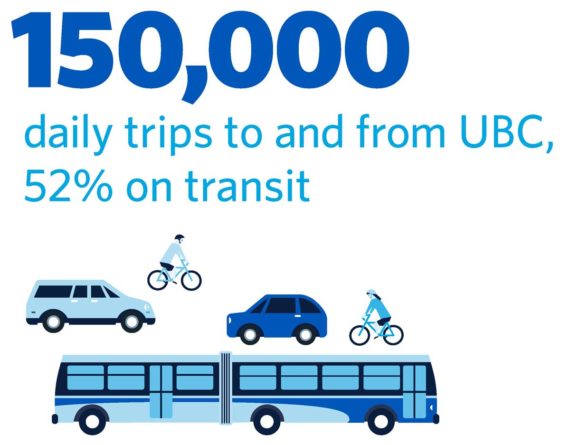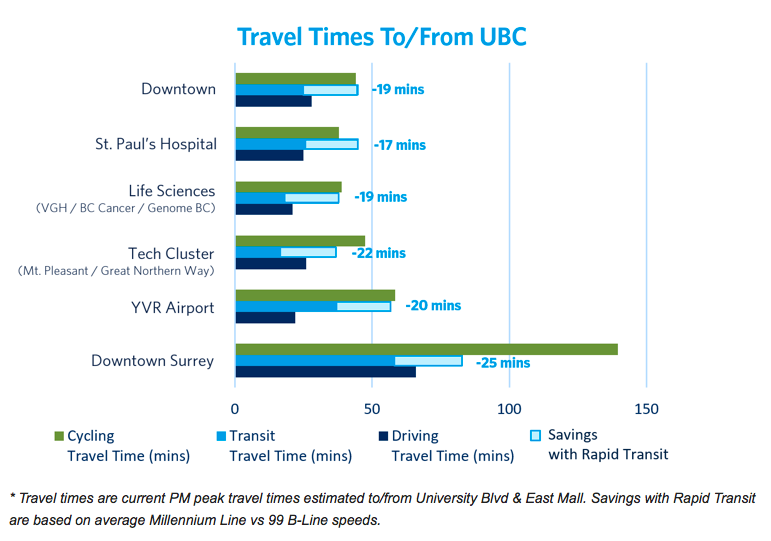Why SkyTrain to UBC

UBC serves Metro Vancouver, the province and the country
As a premier teaching and research institution, B.C.’s third-largest employer, and home to a growing residential community, UBC plays an important role in the regional, provincial and national economies. Better transit access to the Vancouver campus will help realize UBC’s full potential as a regional contributor by connecting the university to research, health, innovation, employment and housing destinations across the Lower Mainland. A rapid transit connection will expand the university’s reach throughout the region, making it an increasingly viable choice for prospective students and potential employees who would not otherwise consider UBC. SkyTrain to UBC will connect over 1 million people within a 60-minute trip to UBC.
Extending the Millennium Line SkyTrain to UBC will contribute to a growing transit network that meets the needs of the entire region, reducing congestion, moving people more quickly and safely between their homes and places of work, and minimizing our impact on the environment. It will also increase access to education and affordable housing options, and encourage economic growth and prosperity throughout the region.
— Professor Santa J. Ono, President and Vice-Chancellor, UBC
Business in Vancouver, December 25, 2018
Thousands of people commute to UBC each day
The daytime population of the Vancouver campus is over 80,000—about the same size as most of BC’s mid-size cities. There are 55,000 students, faculty and staff who commute to UBC each day, which results in 150,000 daily trips to and from UBC. Over 80,000 are on transit. Half of the 55,000 people travelling to UBC each day come from outside the City of Vancouver. This massive volume of UBC-bound traffic is clogging things up, causing long, slow commutes for people who use the Broadway and adjacent corridors and lower productivity for businesses in the area.

The drop in UBC transit ridership caused by the global pandemic is temporary. With the return to in-person learning, reinstatement of the U-Pass BC program and a constrained parking supply at UBC, transit routes to and from UBC were among the first to see ridership rebound. Two of the three bus routes serving Metro Vancouver’s post-secondary institutions that made the strongest gains in ridership serve UBC. The experience with full online teaching, learning and research has underscored the importance of in-person learning and engagement in realizing the mandate of the university.
A seamless, rapid connection to UBC meets the need
The Broadway Subway project will extend the Millennium Line SkyTrain to Arbutus Street, adding six underground stations along a 5.7-kilometre tunnelled route. Travellers headed to UBC will have to transfer to B-Line buses, which will follow the current route of the 99 B-Line through Point Grey to campus.
Technical analyses reveal that these buses will be over capacity on opening day, carrying similar peak volumes as today’s 99 B-Line at Commercial-Broadway. Extending SkyTrain service to UBC would eliminate this inefficient and inconvenient transfer to the B-Line buses at Arbutus. Passengers will benefit from faster, more convenient transit times, and the businesses and residents along the Broadway corridor will benefit from less noise and congestion.
It is anticipated that by 2045 there will be just under 119,000 daily boardings on SkyTrain between Arbutus and UBC alone; higher ridership than the entire rest of the Millennium Line today. With 10,000 people per peak hour passing through, the UBC station, once complete, will be twice as bust as the current busiest station on the entire SkyTrain network (Burrard Station).

SkyTrain is the only technology with room to meet future demand along the corridor beyond about 2045, especially if the region is successful in achieving the TransLink target of 50% of all trips by sustainable modes by that same time. Learn more about the selection of SkyTrain technology for the extension of rapid transit to UBC.

